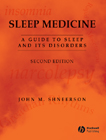On average people spend one third of their life sleeping. An
understanding of the physiology and pathophysiological changes that
take place during this time is, therefore, essential to the medical
care of patients. Sleep disorders can arise from a variety of causes
including respiratory, psychiatric and neurological conditions, as
well as pain and lifestyle changes. Consequently, their understanding
is pertinent to a wide range of clinicians who require an overview of
their diagnosis and treatment.
Written by one of the UK's leading authorities on sleep Medicine,
Sleep Medicine: A Guide to Sleep and its Disorders presents a
practical guide to the clinical problems related to sleep disorders.
An experienced author, John Shneerson writes concisely and presents
the information in a most accessible way. The text is clearly
organised and full use has been made of tables and line diagrams.
Whilst the body of the text is clinical in approach, the scientific
basis of sleep and sleep medicine and the technical aspects of sleep
investigations are explained fully.
The book is divided into three sections. The first group of chapters
considers the fundamentals of sleep, the effects of drugs on sleep
and how to assess sleep complaints. The main body of the book
consists of chapters on individual sleep disorders. Each of these has
a structured approach, outlining both assessment and treatment.
Insomnia, excessive daytime sleepiness, awareness during sleep and
behavioural abnormalities are covered. The final chapters deal with
the important respiratory consequences of upper airway dysfunction,
changes in the control of breathing during sleep and the social
implications of sleep problems.
Sleep medicine is a fast developing discipline which interfaces with
many of the medical specialties. Sleep Medicine: A Guide to Sleep and
its Disorders enables doctors and other health professionals to
access recent advances ensuring that their patients receive the
optimum treatment for their sleep disorders.
-Contents -
1. Nature of Sleep and its Disorders
2. Physiological Basis of Sleep;
3. Drugs and Sleep;
4. Assessment of Sleep Disorders;
5. Insomnia;
6. Excessive Daytime Sleepiness;
7. Behavioural Abnormalities in Sleep;
8. Experiences, Autonomic and Immunological Disorders in Sleep;
9. Respiratory Pump Disorders;
10. Obstructive Sleep Apnoeas and Snoring;
11. Sleep Disorders and Society;
Appendix I - Control of Sleep and Wakefulness;
Appendix II - Circadian Rhythms;
Appendix III - Neurophysiology and anatomy of Sleep and Wakefulness;
Appendix IV - Neurochemistry of Sleep and Wakefulness;
Appendix V - Electrophysiological Recordings During Sleep;
Dr Shneerson is a consultant physician the Director of the
Respiratory Support and Sleep Centre at Papworth Hospital, the
largest sleep centre in the UK. The Centre specializes in the
management of respiratory problems during sleep, and offers a
comprehensive service, including a narcolepsy programme. An well
recognised expert in the field, Dr Shneerson has authored over 200
publications in the sleep and respiratory field.


